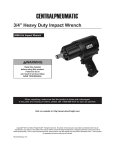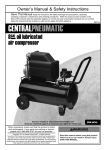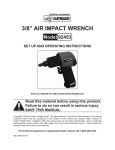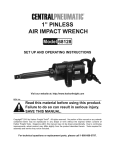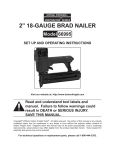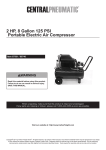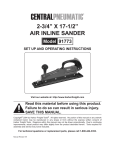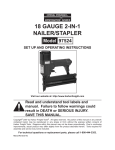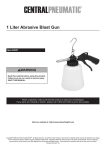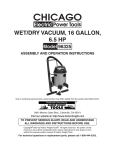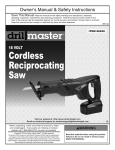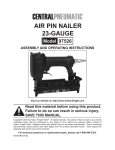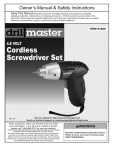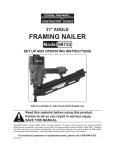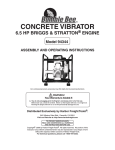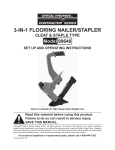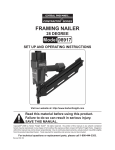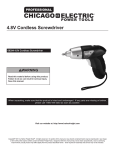Download Harbor Freight Tools Benchtop Blast Cabinet Product manual
Transcript
Abrasive blast cabinet 42202 Set up and Operating Instructions Distributed exclusively by Harbor Freight Tools®. 3491 Mission Oaks Blvd., Camarillo, CA 93011 Visit our website at: http://www.harborfreight.com Read this material before using this product. Failure to do so can result in serious injury. Save this manual. Copyright© 2000, 2009 by Harbor Freight Tools®. All rights reserved. No portion of this manual or any artwork contained herein may be reproduced in any shape or form without the express written consent of Harbor Freight Tools. Diagrams within this manual may not be drawn proportionally. Due to continuing improvements, actual product may differ slightly from the product described herein. Tools required for assembly and service may not be included. For technical questions or replacement parts, please call 1-800-444-3353. Manual Revised 11h Contents Safety Alert Symbol and Signal Words����������������������������� 3 BLAST Gun parts list & parts DIAGRAM��������������������� 17 90 day warranty�������������������� 18 IMPORTANT SAFETY INSTRUCTIONS�������������������������� 3 General�������������������������������������������3 Work area�������������������������������������� 3 Personal safety������������������������� 3 Tool use and care���������������������� 4 Service��������������������������������������������5 Air source�������������������������������������� 5 Symbols and Specific Safety Instructions����������� 5 Symbol Definitions��������������������� 5 Functional Description������� 8 Specifications������������������������������ 8 Components and Controls���� 8 Initial Tool Set Up/ Assembly���������������������������������� 9 Unpacking��������������������������������������� 9 Air Supply��������������������������������������� 9 operating Instructions���� 10 Tool Set Up���������������������������������� 10 Work Piece and Work Area Set Up������������������������������������������ 11 General Operating Instructions���������������������������� 12 User-Maintenance Instructions������������������������ 13 Cleaning and Maintenance��� 13 Troubleshooting���������������������� 15 BLAST CABINET Parts List & assembly diagram���������� 16 Page 2 For technical questions, please call 1-800-444-3353. SKU 42202 Save This Manual NOTICE is used to address practices not related to personal injury. Keep this manual for the safety warnings and precautions, assembly, operating, inspection, maintenance and cleaning procedures. Write the product’s serial number in the back of the manual near the assembly diagram (or month and year of purchase if product has no number). Keep this manual and the receipt in a safe and dry place for future reference. Safety Alert Symbol and Signal Words In this manual, on the labeling, and all other information provided with this product: This is the safety alert symbol. It is used to alert you to potential personal injury hazards. Obey all safety messages that follow this symbol to avoid possible injury or death. DANGER indicates a hazardous situation which, if not avoided, will result in death or serious injury. WARNING indicates a hazardous situation which, if not avoided, could result in death or serious injury. CAUTION, without the safety alert symbol, is used to address practices not related to personal injury. IMPORTANT SAFETY INSTRUCTIONS Instructions Pertaining to a Risk of Fire, Electric Shock, or Injury to Persons WARNING – When using power tools, basic precautions should always be followed, including the following: General To reduce the risk of injury to persons, read all the instructions before using the tool. Work area a. Keep the work area clean and well lighted. Cluttered benches and dark areas increase the risk of electric shock, fire, and injury to persons. b. Keep bystanders, children, and visitors away while operating a power tool. Distractions can result in the loss of control of the tool. CAUTION, used with the safety alert symbol, indicates a hazardous situation which, if not avoided, could result in minor or moderate injury. SKU 42202 Personal safety a. Stay alert. Watch what you are doing and use common sense when operating a power tool. Do For technical questions, please call 1-800-444-3353. Page 3 not use a power tool while tired or under the influence of drugs, alcohol, or medication. A moment of inattention while operating a power tool increases the risk of injury to persons. b. Dress properly. Do not wear loose clothing or jewelry. Contain long hair. Keep hair, clothing, and gloves away from moving parts. Loose clothes, jewelry, or long hair increases the risk of injury to persons as a result of being caught in moving parts. c. Avoid unintentional starting. Be sure the trigger is off before connecting to the air supply. Do not carry the tool with your finger on the trigger or connect the tool to the air supply with the trigger engaged. d. Do not overreach. Keep proper footing and balance at all times. Proper footing and balance enables better control of the tool in unexpected situations. e. conditions. Always wear eye protection. Wear ANSIapproved safety goggles. f. g. Use safety equipment. A dust mask, non-skid safety shoes and a hard hat must be used for the applicable Always wear hearing protection when using the tool. Prolonged exposure to high intensity noise is able to cause hearing loss. Page 4 Tool use and care a. Do not force the tool. Use the correct tool for the application. The correct tool will do the job better and safer at the rate for which the tool is designed. b. Do not use the tool if the trigger does not turn the tool on or off. Any tool that cannot be controlled with the trigger is dangerous and must be repaired. c. Disconnect the tool from the air source before making any adjustments, changing accessories, or storing the tool. Such preventive safety measures reduce the risk of starting the tool unintentionally. Turn off and detach the air supply, safely discharge any residual air pressure, and release the trigger before leaving the work area. d. Store the tool when it is idle out of reach of children and other untrained persons. A tool is dangerous in the hands of untrained users. e. Maintain the tool with care. Keep the tool clean and free of obstructions. A properly maintained tool reduces the risk of accidents and is easier to control. f. Check for misalignment or binding of moving parts, breakage of parts, and any other condition that affects the tool’s operation. If damaged, have the tool serviced before using. Many accidents are caused by poorly maintained tools. There is a risk of bursting if the tool is damaged. For technical questions, please call 1-800-444-3353. SKU 42202 g. Use only accessories that are identified by the manufacturer for the specific tool model. Use of an accessory not intended for use with the specific tool model, increases the risk of injury to persons. Service a. b. Tool service must be performed only by qualified repair personnel. Service or maintenance performed by unqualified personnel could result in a risk of injury. Symbols and Specific Safety Instructions Symbol Definitions Symbol no .../min When servicing a tool, use only identical replacement parts. Use only authorized parts. Air source a. b. Never connect to an air source that is capable of exceeding 200 psi. Over pressurizing the tool may cause bursting, abnormal operation, breakage of the tool or serious injury to persons. Use only clean, dry, regulated compressed air at the rated pressure or within the rated pressure range as marked on the tool. Always verify prior to using the tool that the air source has been adjusted to the rated air pressure or within the rated air-pressure range. Never use oxygen, carbon dioxide, combustible gases or any bottled gas as an air source for the tool. Such gases are capable of explosion and serious injury to persons. Save these instructions. SKU 42202 Property or statement No-load speed Revolutions or reciprocation per minute PSI Pounds per square inch of pressure ft-lb Foot-pounds of torque BPM Blows per minute CFM Cubic Feet per Minute flow SCFM Cubic Feet per Minute flow at standard conditions NPT National pipe thread, tapered NPS National pipe thread, straight WARNING marking concerning Risk of Eye Injury. Wear ANSI-approved eye protection. WARNING marking concerning Risk of Hearing Loss. Wear hearing protection. WARNING marking concerning Risk of Respiratory Injury. Wear NIOSHapproved dust mask/respirator. WARNING marking concerning Risk of Explosion. Specific Safety Instructions 1. Attach all accessories properly to the tool before connecting the air supply. A loose accessory may detach or break during operation. For technical questions, please call 1-800-444-3353. Page 5 2. Disconnect air hose and release any built-up air pressure. Do not service or disassemble the Blast Cabinet with the air hose attached. Always release any built-up air, even after disconnecting hose. 3. Avoid working alone. If an accident happens, an assistant can bring help. 4. Maintain labels and nameplates on the Blast Cabinet. These carry important information. If unreadable or missing, contact Harbor Freight Tools for a replacement. 5. Maintain a firm grip on the Blast Gun when in use. 6. Never point the Blast Gun toward yourself, other people, or animals. Keep all people and animals safely away from the work area. 7. Industrial applications must follow OSHA requirements. 8. Whenever possible, perform an abrasive blasting test on a small area of the object to be blasted. If necessary, adjust the distance to the object and/or change the Nozzle of the Blast Gun for more effective results. 9. Read and understand all safety warnings and precautions as outlined in the manufacturer’s manual for the object you intend to blast with abrasives. 10. Obey the manual for the air compressor used to power this tool. 12. WARNING: The brass components of this product contain lead, a chemical known to the State of California to cause birth defects (or other reproductive harm). (California Health & Safety code § 25249.5, et seq.) 13. WARNING: This product, when used for abrasive blasting and similar applications, produces chemicals known to the State of California to cause cancer and birth defects (or other reproductive harm). (California Health & Safety Code § 25249.5, et seq.) Silicosis and Aluminum Oxide Warnings Warning: Abrasive blasting with sand containing crystalline silica can cause serious or fatal respiratory disease. Exposure to crystalline silica may cause silicosis (a serious lung disease), cancer and death. Exposure to aluminum oxide (a dust generated from material removing processes) can result in eye, skin and breathing irritation. Always use a NIOSH (National Institute for Occupational Safety and Health) approved respirator and safety goggles. Avoid skin exposure. Proper ventilation in the work area is required. Read and understand the 10 recommended measures below to reduce crystalline silica exposures in the workplace and prevent silicosis and silicosis related deaths. 11. Install an in-line shutoff valve to allow immediate control over the air supply in an emergency, even if a hose is ruptured. Page 6 For technical questions, please call 1-800-444-3353. SKU 42202 NIOSH recommends the following measures to reduce crystalline silica exposures in the workplace and prevent silicosis and silicosis-related deaths: 1. Prohibit silica sand (or other substances containing more than 1% crystalline silica) as an abrasive blasting material and substitute less hazardous materials. 2. Conduct air monitoring to measure worker exposures. 3. Use containment methods such as blast-cleaning machines and cabinets to control the hazard and protect adjacent workers from exposure. 4. Practice good personal hygiene to avoid unnecessary exposure to silica dust. 5. Wear washable or disposable protective clothes at the work site. Shower and change into clean clothes before leaving the work site to prevent contamination of cars, homes and other work areas. 6. Use respiratory protection when source controls cannot keep silica exposures below the NIOSH REL. 7. Provide periodic medical examinations for all workers who may be exposed to crystalline silica. 8. Post signs to warn workers about the hazard and to inform them about required protective equipment. 9. Provide workers with training that includes information about health effects, work practices and protective equipment for crystalline silica. SKU 42202 10. Report all cases of silicosis to State health departments and to OSHA or the Mine Safety and Health Administration (MSHA). Vibration Precautions This tool vibrates during use. Repeated or long-term exposure to vibration may cause temporary or permanent physical injury, particularly to the hands, arms and shoulders. To reduce the risk of vibration-related injury: 1. Anyone using vibrating tools regularly or for an extended period should first be examined by a doctor and then have regular medical checkups to ensure medical problems are not being caused or worsened from use. Pregnant women or people who have impaired blood circulation to the hand, past hand injuries, nervous system disorders, diabetes, or Raynaud’s Disease should not use this tool. If you feel any symptoms related to vibration (such as tingling, numbness, and white or blue fingers), seek medical advice as soon as possible. 2. Do not smoke during use. Nicotine reduces the blood supply to the hands and fingers, increasing the risk of vibration-related injury. 3. Wear suitable gloves to reduce the vibration effects on the user. 4. Use tools with the lowest vibration when there is a choice. 5. Include vibration-free periods each day of work. 6. Grip tool as lightly as possible (while still keeping safe control of it). Let the tool do the work. For technical questions, please call 1-800-444-3353. Page 7 7. 8. To reduce vibration, maintain tool as explained in this manual. If abnormal vibration occurs, stop immediately. The warnings and precautions discussed in this manual cannot cover all possible conditions and situations that may occur. It must be understood by the operator that common sense and caution are factors which cannot be built into this product, but must be supplied by the operator. Save these instructions. Functional Description Specifications Compressor Requirements 1 HP or larger compressor Air Inlet 1/4” NPT Nozzle Type Ceramic - .18”, .19”, .22”, .27” Air Consumption 10 CFM @ 100 PSI Operating Air Pressure Up to 100 PSI Hopper Capacity 30 Gallons Use of 3/8” supply hose is recommended. Components and Controls Tempered Glass Window (23) Side Door (3) Door Latch (5) Glove Port (16) Hopper (13) Siphon Tube (12) Hex Wrench Window Liners (22) Siphon Hose (8) Figure 1 Page 8 Ceramic Nozzles (13A - 16A) Blast Gun (7) Air Hose Connector (30) For technical questions, please call 1-800-444-3353. SKU 42202 Initial Tool Set Up/ Assembly Coupler Plug Tool Read the entire Important Safety Information section at the beginning of this manual including all text under subheadings therein before set up or use of this product. Quick Coupler Valve When unpacking, make sure that the item is intact and undamaged. If any parts are missing or broken, please call Harbor Freight Tools at 1-800-444-3353 as soon as possible. Quick Coupler 1. Air Supply To prevent explosion: Use only clean, dry, regulated, compressed air to power this tool. Do not use oxygen, carbon dioxide, combustible gases, or any other bottled gas as a power source for this tool. Filter Regulator with Pressure Gauge Recommended Air Line Components • This air tool may be shipped with a protective plug covering the air inlet. Remove this plug before set up. Dryer Air Hose on Reel Air Compressor Note: For additional information regarding the parts listed in the following pages, refer to the Assembly Diagram near the end of this manual. Unpacking Coupler Plug Incorporate a filter, regulator with pressure gauge, dryer, in-line shutoff valve, and quick coupler for best service, as shown in the diagram above. An in-line shutoff ball valve is an important safety device because it controls the air supply even if the air hose is ruptured. The shutoff valve should be a ball valve because it can be closed quickly. Note: An oiler system should not be used with this tool. The oil will mix with the material being propelled, causing poor results. 2. To test the unit, attach an air hose to the compressor’s air outlet. Connect the air hose to the air inlet of the tool. Other components, such as a coupler plug and quick coupler, will make operation more efficient, but are not required. WARNING! To prevent serious injury from accidental operation: Do not install a female quick SKU 42202 For technical questions, please call 1-800-444-3353. Page 9 coupler on the tool. Such a coupler contains an air valve that will allow the air tool to retain pressure and operate accidentally after the air supply is disconnected. Note: Air flow, and therefore tool performance, can be hindered by undersized air supply components. 3. Close the in-line safety valve between the compressor and the tool. 4. Make sure the Trigger of the Blast Gun (7) is not engaged. 5. Turn on the air compressor according to the manufacturer’s directions and allow it to build up pressure until it cycles off. 6. Adjust the air compressor’s output regulator so that the air output is enough to properly power the tool, but the output will not exceed the tool’s maximum air pressure at any time. Adjust the pressure gradually, until the desired pressure is reached. 7. Inspect the air connections for leaks. Repair any leaks found. 8. Turn off and detach the air supply, safely discharge any residual air pressure, and release the throttle and/or turn the switch to its off position to prevent accidental operation. Note: Residual air pressure should not be present after the tool is disconnected from the air supply. However, it is a good safety measure to attempt to discharge the tool in a safe fashion after disconnecting to ensure that the tool is disconnected and unpowered. Page 10 operating Instructions Read the entire Important Safety Information section at the beginning of this manual including all text under subheadings therein before set up or use of this product. Inspect tool before use, looking for damaged, loose, and missing parts. If any problems are found, do not use tool until repaired. Tool Set Up To prevent serious injury from accidental operation: Release the Trigger, detach the air supply, safely discharge any residual air pressure in the tool, and release the Trigger again before performing any inspection, maintenance, or cleaning procedures. To prevent serious injury: Do not adjust or tamper with any control or component in a way not specifically explained within this manual. Improper adjustment can result in tool failure or other serious hazards. For technical questions, please call 1-800-444-3353. SKU 42202 Dust Collection Outlet Air Hose Inlet Blast Gloves (18) Work Piece and Work Area Set Up 1. Designate a work area that is clean and well-lit. The work area must not allow access by children or pets to prevent distraction and injury. 2. Route the air hose along a safe route to reach the work area without creating a tripping hazard or exposing the air hose to possible damage. The air hose must be long enough to reach the work area with enough extra length to allow free movement while working. 3. Place the Blast Cabinet on a sturdy level work surface, positioning the Cabinet at a level so that you can comfortably access the Glove openings and easily see into the Blast Cabinet through the Tempered Glass Window (23). The work surface needs to be able to support the weight of the Blast Cabinet and the abrasive which will fill the Hopper, the work piece and any additional material required to be close at hand. 4. If needed, position a light (sold separately) so the interior of the Blast Cabinet is well lit (use only utility light bulbs). 5. It is recommended that you set up a vacuum dust collector (sold separately) to remove media dust while blasting. Attach the vacuum hose through the Dust Collection Outlet. Vent Door Latch (5) Hole in Metal Floor for Siphon Tube (12) (14) so that it is resting in the Hopper (13). Metal Floor (14) Siphon-Gun Assembly Hopper (13) Cap (9) (underneath unit) Figure 2 1. Remove any protective film from the outside of the Tempered Glass Window (23), or any other part of the Blast Cabinet. 2. Remove the protective backing from one of the three Window Liners (22) and adhere it to the inside of the Tempered Glass Window (23). 3. To install or change the Ceramic Nozzle, use the Hex Wrench to loosen the Set Screw (11A) closest to the tip of the Blast Gun. Slide the desired Nozzle in place and tighten the Set Screw. Note: By changing to the next larger size of Nozzle, production can increase significantly. Larger size Nozzles produce a larger cleaning pattern. This also requires a higher air pressure and greater air flow. 4. Slide one end of the Siphon Hose (8) onto the Siphon Tube (12) and the other end onto the Blast Gun (7). 5. Insert the Siphon Tube through the corner opening of the Metal Floor SKU 42202 When using a vacuum dust collector, clean the filter periodically to maintain good suction and effectiveness of the For technical questions, please call 1-800-444-3353. Page 11 vacuum. Use the appropriate vacuum for the job. 6. Fill the Hopper (13) with approximately 10 pounds of an appropriate abrasive, such as glass beads or walnut shells, checking to ensure that the abrasives are dry and clean. Do not use harsh abrasives such as steel shot or aluminum oxide. 7. Set the compressor’s pressure regulator to 100 PSI. Do not set it over 100 PSI. 8. Route the compressor hose from the outside of the Cabinet to the inside through the Air Hose Inlet in the back of the Cabinet, then connect it to the Air Hose Connector (30) on the Blast Gun inside the Cabinet. 9. Holding the Blast Gun so that it is pointing away from you, open the shut-off valve. If leaking is detected, disconnect the air hose and repair before use. can easily move your hands and grip objects. 4. Grip the gun with one hand. Point the nozzle at the bottom of the Cabinet and operate the Gun for a moment to ensure everything is working correctly. If leaking is detected, or blasting material dust is escaping the side door seals, disconnect the air hose and have it repaired before using. 5. Hold the object you are working with in your other hand. Position your fingers so the Blast Glove (18) is not in the way of the area you are blasting. You may have to re-position your fingers many times during the blasting to ensure that you reach every area of your object. 6. Squeeze the Trigger on the Blast Gun to begin operation. Release the Trigger to stop. Aim the nozzle directly at the surface of the material. Bring the nozzle to within 2 inches of the material if necessary. Move the Gun in a sideto-side or circular motion, always making sure that your fingers are not in the way. General Operating Instructions WARNING: Wear ANSI-approved safety goggles, full face shield and a NIOSH-approved protective dust mask or respirator when using the Blast Cabinet. 1. Place the material to be sandblasted on the Metal Floor (14) inside the Blast Cabinet. 2. Close the Side Door (3) and hook the Door Latch (5) over the door flange and lock in place. Check to make sure the Latch is secured. 3. Place your hands into the Blast Gloves, making sure your fingers are in the proper positions and that you Page 12 Use even passes of the Gun to remove rust, body filler, or other soft materials. 7. To check on the progress of your blasting, remove your hand from the gun first and pull your hand from the Glove. Remove your other hand. Once the gun is off, open the door and inspect your material. If additional blasting is required, follow steps 1 through 7 as needed. For technical questions, please call 1-800-444-3353. SKU 42202 Note: Use caution when sandblasting unfamiliar material. Test the tool on a small area before proceeding. This will ensure you will not damage or pit the material you wish to sandblast. WARNING: Do not aim the gun at your fingers or the Blast Gloves. Do not operate the gun with the Side Door open or outside of the Blast Cabinet. 8. 9. If the tool requires more force to accomplish the task, verify that the tool receives sufficient, unobstructed airflow (CFM) and increase the pressure (PSI) output of the regulator up to the maximum air pressure rating of this tool. CAUTION! To prevent tool and accessory failure, resulting in injury: Do not exceed the tool’s maximum air pressure rating. If the tool still does not have sufficient force at maximum pressure and sufficient airflow, then a larger tool may be required. Once completed, remove your hands from the Gloves and shut off the compressor. Open the Side Door and remove your material from the Blast Cabinet. 10. To prevent accidents, turn off the tool, detach the air supply, safely discharge any residual air pressure in the tool, and release the Trigger after use. Clean external surfaces of the tool with a clean, dry cloth, and apply a thin coat of tool oil. Then store the tool indoors out of children’s reach. SKU 42202 User-Maintenance Instructions Procedures not specifically explained in this manual must be performed only by a qualified technician. To prevent serious injury from accidental operation: Release the Trigger, detach the air supply, safely discharge any residual air pressure in the tool, and release the Trigger again before performing any inspection, maintenance, or cleaning procedures. To prevent serious injury from tool failure: Do not use damaged equipment. If abnormal noise, vibration, or leaking air occurs, have the problem corrected before further use. Cleaning and Maintenance Note: These procedures are in addition to the regular checks and maintenance explained as part of the regular operation of the air-operated tool. Changing the Blasting Medium It is not necessary to remove the blasting medium from the Hopper (13) after every use. However, clean out the Hopper when a different blasting medium is to be used or when the medium gets worn down. To clean the Hopper: For technical questions, please call 1-800-444-3353. Page 13 WARNING: Wear ANSI-approved safety goggles, full face shield and a NIOSH-approved protective dust mask or respirator when replacing the abrasive medium in the Blast Cabinet. fill the Hopper with new blasting medium. Blast Gun Maintenance: After every use, clean out the Blast Gun. To clean the gun: 1. Disconnect the dust collection system from the Blast Cabinet. 1. 2. Disconnect Air Hose and Syphon Hoses from the Gun. Remove the Siphon Hose (8) from the Blast Gun (7). 2. 3. Remove the Gun from the Cabinet. Operate the Gun for a few seconds to clear the passages. 4. Pull the Gloves through the glove holes so that they are out of the way of the inside of the Blast Cabinet. 3. Turn off the shut-off valve. 4. Disconnect the air compressor. 5. Discharge any residual air from the line and the Gun. 5. Remove the Metal Floor from the Blast Cabinet. 6. Straddle the Blast Cabinet over two saw horses (sold separately) with an open container below which is large enough to hold the abrasive material in the hopper. 7. Unthread the Cap (9) at the bottom of the Hopper and allow the abrasive medium to flow into the container. 8. Use your compressor set at 10 PSI to help blow any excess abrasive out of the hopper and into the container. Also, use the compressor to clean abrasive out of the Blast Gun and the Siphon Hose (8) and Siphon Tube (12). 9. Replace the Cap and the Metal Floor once the Hopper is empty. Seals Sandblasting is a damaging operation. In time, the internal parts of the Blast Gun (7) will become worn. When performance of the Blast Gun decreases, take it to a qualified service technician for repair. Daily - Air Supply Maintenance: Every day, perform maintenance on the air supply according to the component manufacturers’ instructions. The moisture filter must be regularly drained. Performing routine maintenance on the air supply will allow the tool to operate more safely and will also reduce wear on the tool. 10. Push the Gloves back into the Blast Cabinet. 11. Reassemble the Siphon Hose, Siphon Tube and Blast Gun and Page 14 For technical questions, please call 1-800-444-3353. SKU 42202 Troubleshooting Problem Possible Causes Decreased output. 1. Not enough air pressure and/ or air flow. 2. Obstructed trigger. Likely Solutions 1. Check for loose connections and make sure that air supply is providing enough air flow (CFM) at required pressure (PSI) to the tool’s air inlet. Do not exceed maximum air pressure. 2. Clean around trigger to ensure free movement. 3. Clean air inlet screen of buildup. 3. Blocked air inlet screen (if equipped). 4. Air leaking from loose housing. 4. Make sure housing is properly assembled and tight. 5. Mechanism contaminated. 5. Have qualified technician clean and lubricate mechanism. Install in-line filter in air supply as stated in Initial Set Up: Air Supply. 6. Damaged or kinked air/ 6. Inspect and replace hose. abrasive hose. Housing heats 1. Worn parts. 1. Have qualified technician inspect internal during use. mechanism and replace parts as needed. 2. Long periods of continuous 2. Use intermitantly, allowing cool-off periods. usage. Severe air 1. Cross-threaded housing 1. Check for incorrect alignment and uneven leakage. components. gaps. If cross-threaded, disassemble and (Slight air leakage replace damaged parts before use. is normal, 2. Damaged valve or housing. 2. Replace damaged components. especially on older 3. Dirty, worn or damaged valve. 3. Clean or replace valve assembly. tools.) Follow all safety precautions whenever diagnosing or servicing the tool. Disconnect air supply before service. PLEASE READ THE FOLLOWING CAREFULLY The manufacturer and/or distributor has provided the parts list and assembly diagram in this manual as a reference tool only. Neither the manufacturer or distributor makes any representation or warranty of any kind to the buyer that he or she is qualified to make any repairs to the product, or that he or she is qualified to replace any parts of the product. In fact, the manufacturer and/ or distributor expressly states that all repairs and parts replacements should be undertaken by certified and licensed technicians, and not by the buyer. The buyer assumes all risk and liability arising out of his or her repairs to the original product or replacement parts thereto, or arising out of his or her installation of replacement parts thereto. SKU 42202 For technical questions, please call 1-800-444-3353. Page 15 BLAST CABINET Parts List & assembly diagram Part 1 2 3 4 5 6 7 8 9 10 11 12 13 14 15 16 17 18 19 Description Body Foam Gasket Side Door Vent Baffle Door Latch Door Edge Trim Blast Gun Siphon Hose Cap Connector Rubber Washer Siphon Tube Hopper Metal Floor Nut Glove Port Glove Clamp Blast Glove Rubber Tube Page 16 Qty 1 1 1 1 1 1 1 1 1 1 1 1 1 1 1 2 2 2 1 Part 20 21 22 23 24 25 26 27 28 29 31 32 33 34 Description Rubber Plug Rubber Trim Window Liner Tempered Glass Window Window Frame Pan Screw Hinge Bolt Rubber Trim Foam Gasket Bolt Spring Washer Nut Strengthening Piece For technical questions, please call 1-800-444-3353. Qty 1 1 3 1 1 26 1 6 1 1 12 18 18 1 SKU 42202 BLAST Gun parts list & parts DIAGRAM Part 1A 2A 3A 4A 5A 6A 7A 8A 9A Description Qty Bolt Plug Rubber Washer Spring Needle Valve Spring Rubber Washer Gun Body Seal Washer Connector 1 1 1 1 1 1 1 1 1 Part 10A 11A 12A 13A 14A 15A 16A 17A 14A Description Seal Washer Set Screw Siphon Pipe Ceramic Nozzle - .18” Ceramic Nozzle - .19” Ceramic Nozzle - .22” Ceramic Nozzle - .27” Connector 15A Qty 2 2 1 1 1 1 1 1 16A 17A Note: When ordering replacement parts, add an “A” suffix to part numbers shown in this Assembly Diagram. SKU 42202 For technical questions, please call 1-800-444-3353. Page 17 90 Day Warranty Harbor Freight Tools Co. makes every effort to assure that its products meet high quality and durability standards, and warrants to the original purchaser that this product is free from defects in materials and workmanship for the period of 90 days from the date of purchase. This warranty does not apply to damage due directly or indirectly, to misuse, abuse, negligence or accidents, repairs or alterations outside our facilities, criminal activity, improper installation, normal wear and tear, or to lack of maintenance. We shall in no event be liable for death, injuries to persons or property, or for incidental, contingent, special or consequential damages arising from the use of our product. Some states do not allow the exclusion or limitation of incidental or consequential damages, so the above limitation of exclusion may not apply to you. This warranty is expressly in lieu of all other warranties, express or implied, including the warranties of merchantability and fitness. To take advantage of this warranty, the product or part must be returned to us with transportation charges prepaid. Proof of purchase date and an explanation of the complaint must accompany the merchandise. If our inspection verifies the defect, we will either repair or replace the product at our election or we may elect to refund the purchase price if we cannot readily and quickly provide you with a replacement. We will return repaired products at our expense, but if we determine there is no defect, or that the defect resulted from causes not within the scope of our warranty, then you must bear the cost of returning the product. This warranty gives you specific legal rights and you may also have other rights which vary from state to state. Record Product’s Serial Number Here: Note: If product has no serial number, record month and year of purchase instead. Note: Some parts are listed and shown for illustration purposes only, and are not available individually as replacement parts. REV 11h Page 18 For technical questions, please call 1-800-444-3353. SKU 42202



















